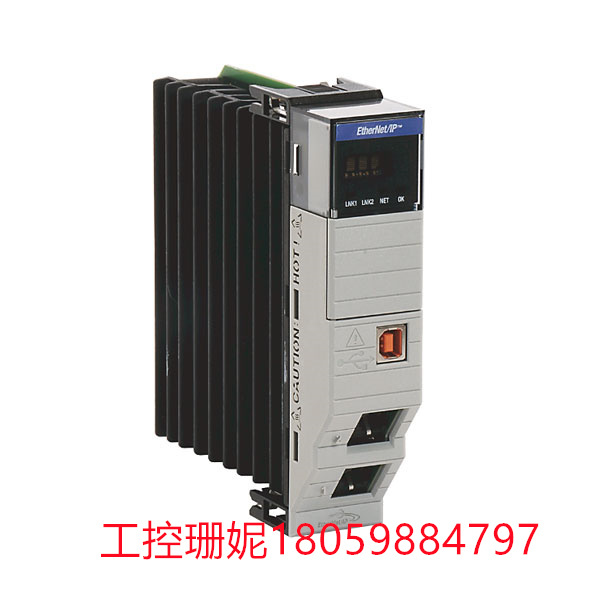
Allen-Bradley 1756-EN2TR是ControlLogix通信模块系列的一部分。它是一种以太网/IP(以太网工业协议)双端口接口通信模块。它支持常规消息传递、实时IO消息传递以及实时控制、时间同步和运动等应用程序的信息交换。1756-EN2TR还允许同时传输安全和控制数据以及诊断信息,从而符合CIP安全标准。它使用先进的通信芯片和物理介质。
1756-EN2TR模块具有10-100 Mbps 以太网/IP通信速率,并使用双铜缆。它支持256个Logix和128个TCPIP通信连接。它最多可以支持8个轴,用于以太网/IP网络上的集成运动,并在1.5V DC时消耗1A电流。它的最大功耗为5.1 W,热耗散为17.4 BTU/小时。它可以安装在ControlLogix机箱的任何插槽中。对于接线,它使用非屏蔽RJ45、5类双绞线电缆连接器与控制器连接。要运行以太网/IP网络,必须定义IP地址、子网掩码、网关等参数。
PLC以太网模块1756-EN2TR在全球范围内采购自动化零件阿米控技术是用于工业自动发货零部件的搜索引擎。我们帮助您快速找到零件!工业控制"备品备件"业务的关键供应商全球交付您的新零件,或已停产的零件新零件(广泛选择零件〉我们提供各种品牌的优质零件,您一定可以找到满足您自动化更换需求的零件。快速订单处理(省心)急需自动化那部分吗?我们的订单履行过程非常轻松,并且可以在24小时内迅速完成周转。全球配送借助我们已建立的全球合作伙伴网络,我们能够随时随地在全球范围内提供交付服务。PLC与继电接触器控制的重要区别之一就是工作方式不同。继电接触器控制是按"并行""方式工作的,也就是说是按同时执行的方式工作的,只要形成电流通路,就可能有几个继电器同时动作。而PLC是以反复扫描的式工作的,它是循环地连续逐条执行程序,任一时刻它只能执行一条指令,这就是说PLC是以"串行方式工作的。这种串行工作方式可以避免继电接触器控制的触点竞争和时序失配问题。
总之,采用循环扫描的工作方式也是PLC区别于微机的最大特点,使用者应特别注意。在电动机控制接线中,主电路中装有熔断器,为什么还要加装热继电器?它们各起何作用,能否互相代替?而在电热及照明线路中,为什么只装熔断器而不装热继电器?因为熔断器在电气线路中主要起短路保护和严重过载保护作用,而热继电器主要用于过载保护.两者不能互为代用,但可以互为补充.如果用容断器作电动机的过载保护,为了防止电动机在启动过程中熔断器熔断,容断器熔体的à定电流一般应取电动机额定电流的2.5~3倍,这样即使电动机长时间过负荷50%,断器也不会熔断,而电动机可能因长时间过负荷而烧坏.所以不能用熔断器作过负载保护.而热继电器是利用电流的热效应来工作的,由于热惯性的影响,尽管发生短路时电流很大,也不可能使热继电器立即动作,这样就延长了短路故障的景响时间,对供电系统及用电设备会造成危害.所以也不能用热继电器作为短路保护.对于电热及照明设备,由于负载的性质不同于电动机的拖动负载,一般来说,它们不会出现过负载现象,所以,一般不装备热继电器,而只装备熔断器,主要起短路保护作用。

The Allen-Bradley 1756-EN2TR is part of the ControlLogix family of communication modules. It is an Ethernet /IP(Ethernet Industrial Protocol) dual-port interface communication module. It supports regular messaging, real-time IO messaging, and information exchange for applications such as real-time control, time synchronization, and motion. The 1756-EN2TR also allows the simultaneous transmission of security and control data as well as diagnostic information, thus complying with CIP security standards. It uses advanced communication chips and physical media.
The 1756-EN2TR module has a 10-100 Mbps Ethernet /IP communication rate and uses double copper cables. It supports 256 Logix and 128 TCPIP communication connections. It can support up to eight axes for integrated motion over Ethernet /IP networks and consumes 1A current at 1.5V DC. It has a maximum power consumption of 5.1W and a heat dissipation of 17.4 BTU/ hour. It can be installed in any slot in the ControlLogix chassis. For wiring, it uses an unshielded RJ45, Class 5 twisted pair cable connector to connect to the controller. To run an Ethernet /IP network, you must define parameters such as IP address, subnet mask, gateway, and so on.
PLC Ethernet Module 1756-EN2TR Sourcing automation parts worldwide Amicron technology is the search engine for the automatic delivery of parts in industry. We help you find parts quickly! The key supplier for the Industrial Control "Spare Parts" business delivers your new parts, or discontinued parts, worldwide (Wide selection of Parts > We offer quality parts from a wide range of brands, and you are sure to find the part that meets your automated replacement needs. Fast order processing (Worry free) Need to automate that part? Our order fulfillment process is very easy and can be completed quickly within 24 hours. Global Delivery With our established network of global partners, we are able to provide delivery services anywhere, anytime, worldwide. One of the important differences between PLC and relay contactor control is the different way of working. The relay contactor control works in a "parallel" mode, that is, it works in a way that executes simultaneously, as long as a current path is formed, several relays may operate at the same time. The PLC is a type of work with repeated scanning, it is a continuous cycle to execute the program one by one, at any time it can only execute one instruction, which means that the PLC works in a serial way. This serial mode of operation can avoid contact competition and timing mismatch problems of relay contactor control.
In short, the working mode of cyclic scanning is also the biggest feature of PLC that is different from the microcomputer, and users should pay special attention to it. In the motor control wiring, the main circuit is equipped with a fuse, why do you need to install a thermal relay? What do they do? Can they replace each other? And in the electric heating and lighting lines, why only install fuses and not thermal relays? Because the fuse mainly plays the role of short circuit protection and serious overload protection in the electrical line, and the thermal relay is mainly used for overload protection. The two cannot substitute for each other, but they can complement each other. If the breaker is used as the overload protection of the motor, in order to prevent the fuse from being blown during the start of the motor, the constant current of the breaker melt should generally be 2.5 to 3 times the rated current of the motor, so that even if the electric load is 50% for a long time, the breaker will not be blown, and the motor may be burned out due to long-term overload. Therefore, the fuse cannot be used for overload protection. The thermal relay is the use of the thermal effect of the current to work, due to the influence of thermal inertia, although the short-circuit current is very large, it is impossible to make the thermal relay action immediately, which extends the short-circuit fault scene time, which will cause harm to the power supply system and electrical equipment. Therefore, thermal relays cannot be used as short-circuit protection. For electric heating and lighting equipment, because the nature of the load is different from the drag load of the motor, in general, they will not appear over the load phenomenon, so, generally not equipped with thermal relays, but only equipped with fuses, mainly plays a short circuit protection role.

Copyright © 2022-2024 厦门雄霸电子商务有限公司 版权所有 备案号:闽ICP备14012685号-33